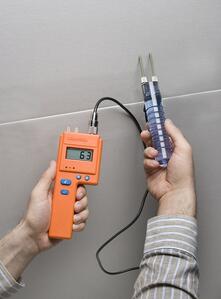Builders and flooring contractors sometimes rely on calcium chloride testing for monitoring the moisture content of a concrete slab to determine whether or not the slab is ready to receive a floor covering. Calcium chloride testing provides a measurement of the moisture (vapor emission) in the upper ½ to 1/4in of the slab, however, experts debate whether or not it gives contractors the whole picture. While it is critical that contractors know what the surface moisture of the slab is, it is very important to have the whole picture regarding the moisture content of the slab.
To help improve the process of accurately measuring moisture within concrete, ASTM developed the F-2170 standard. The F2170 standard is a test method with some distinct advantages over calcium chloride. The main advantage is that this testing method places probes inside the concrete slab itself. This process, called the in-situ method, gives the contractor an accurate relative humidity (RH) reading from within the concrete slab itself. RH testing is an excellent tool in predicting the behavior of the slab after it has come into equilibrium. Used in this way, it predicts potential moisture-related flooring failures.
Concrete absorbs water, and it can take upwards of 30-60 days for a 4-5” thick slab to cure properly. Once the concrete has cured for at least 30 days, testing for moisture can begin. Because it takes so long for concrete to dry even in ideal conditions, attempting moisture tests before the 30 day mark is often a waste. If you are working in an especially humid environment, it may take even longer for the concrete to be ready for testing.
Moisture measurements in concrete need to be taken prior to the application of adhesives, floor coverings, or other structural elements. If excess moisture is left in your concrete slab, any adhesive, wood, linoleum, tile, or spray-on resilient flooring that you install can ultimately fail, possibly lead to litigation, and have to be removed and replaced at considerable expense.
Imagine finishing a large construction project, such as a new school, only to have to tear up the flooring after installation because of defects in the floor caused by trapped moisture in the concrete. Such a problem poses a safety hazard for the students, staff, and faculty, so it would have to be corrected. A proper moisture test could have identified the problem beforehand, but now the construction deadline will be missed, a penalty will be applied to the construction contract, and material costs will go up.
Because of such potential disasters, it is better to correct any moisture problems as soon as possible. Whether the concrete slab is intended for a healthcare facility, school, warehouse, or office building, ASTM F2170 testing should be used in order to prevent both structural and cosmetic damage to your finished building.
You need to have moisture /RH meters and sensors that will give you a high degree of accuracy in your measurements.
Your equipment should be able to measure the relative humidity (RH) of the concrete, as well as the ambient temperature of the surroundings. By determining the moisture conditions both within and around the slab, it is easier to determine exactly when it will be safe to develop on the concrete.
 Using a meter that conforms to ASTM F2170 using in-situ probes that go inside the concrete make it much easier to be accurate in measuring the moisture of the concrete at its core.
Using a meter that conforms to ASTM F2170 using in-situ probes that go inside the concrete make it much easier to be accurate in measuring the moisture of the concrete at its core.
It is critical for you to know that lurking beneath the seemingly solid surface of the concrete could be moisture that may one day cause floor cupping, cracking, and buckling if it is not properly dried. For that reason, you need accurate and thorough moisture testing for your concrete slabs when you are working with any sizable amount of concrete.
Don't rely solely on calcium chloride testing that only gives you a reading of moisture at the surface of your concrete. Get the whole picture by using the latest, most reliable ASTM F2170-compliant meters that take advantage of in-situ probes in addition to your regular calcium chloride testing. The use of both methods together provides good data and increased confidence in making your decisions about how to install flooring.
If you need an accurate, reliable moisture meter, or have more questions about how excess moisture can adversely affect your concrete slab and the construction above it, contact us right away.

Comments